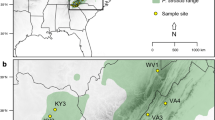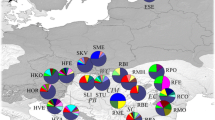Abstract
Thirteen natural populations from throughout the range of the Chinese pine (Pinus tabulaeformis Carr.) were examined using inter-simple sequence repeat markers to characterize the genetic structure at the species level and to compare the extent and distribution of genetic variation among central, intermediate, and marginal populations. Although the total genetic variation in the Chinese pine was mainly maintained within populations, the genetic differentiation among populations was significant (P < 0.001). The genetic divergence was significantly correlated with geographic distance (P < 0.05). Genetic diversity tended to decrease from the central to intermediate and marginal populations. The marginal populations had significantly lower intrapopulation genetic diversity than central populations (P < 0.05). Cluster analysis based on Nei’s unbiased genetic distances confirmed the difference among four central populations and the rest. Both historical and contemporary factors may have played key roles in shaping the spatial genetic structure of this species.



Similar content being viewed by others
References
Beaulieu J, Simon JP (1994) Genetic structure and variability in Pinus strobus L. in Quebec. Can J For Res 24:1726–1733
Bi CX, Guo JZ, Zhang YZ (1998) Variation of isozyme in natural populations of Chinese pine. J Northwest For Univ 13(4):39–43
Chen KM, Abbott RJ, Milne RI, Tian XM, Liu JQ (2008) Phylogeography of Pinus tabulaeformis Carr. (Pinaceae), a dominant species of coniferous forest in northern China. Mol Ecol 17:4276–4288
Eckert CG, Samis KE, Lougheed SC (2008) Genetic variation across species’ geographical ranges: the central-marginal hypothesis and beyond. Mol Ecol 17:1170–1188
Excoffier L, Laval G, Schneider S (2005) Arlequin ver. 3.0: an integrated software package for population genetics data analysis. Evol Bioinform Online 1:47–50
Fazekas AJ, Yeh FC (2001) Random amplified polymorphic DNA diversity of marginal and central populations in Pinus contorta subsp. latifolia. Genome 44:13–22
Feng FJ, Han SJ, Wang HM (2006) Genetic diversity and genetic differentiation of natural Pinus koraiensis populations. J For Res 17(1):21–24
Gamache I, Jaramillo-Correa JP, Payette S, Bousquet J (2003) Diverging patterns of mitochondrial and nuclear DNA diversity in subarctic black spruce: imprint of a founder effect associated with postglacial colonization. Mol Ecol 12:891–901
Gapare WJ, Aitken SN, Ritland CE (2005) Genetic diversity of core and peripheral Sitka spruce (Picea sitchensis (Bong.) Carr) populations: implications for conservation of widespread species. Biol Conserv 123(1):113–123
Guo ZJ, Zhang YZ, Zhang CX, Li ZQ, Bi CX (1996) Genetic structure of natural populations of Chinese pine. J Northwest For Univ 11(4):12–18
Guries RP, Ledig FT (1982) Genetic diversity and population structure in pitch pine (Pinus rigida Mill.). Evolution 36:387–402
Kremenetski CV, Liu KB, MacDonald GM (1998) The late Quaternary dynamics of pine in northern Asia. In: Richardson DM (ed) Ecology and biogeography of Pinus. Cambridge University Press, Cambridge, UK, pp 95–106
Labra M, Grassi F, Sgorbati S, Ferrari C (2006) Distribution of genetic variability in southern populations of Scots pine (Pinus sylvestris) from the Alps to the Apennines. Flora 201:468–476
Ledig FT (1998) Genetic variation in Pinus. In: Richardson DM (ed) Ecology and biogeography of Pinus. Cambridge University Press, Cambridge, UK, pp 251–280
Li P, Adams WT (1989) Range-wide patterns of allozyme variation in Douglas fir (Pseudotsuga menziesii). Can J For Res 19:149–161
Li HY, Jiang J, Liu GF, Ma XJ, Dong JX, Lin SJ (2005) Genetic variation and division of Pinus sylvestris provenances by ISSR. J For Res 16(3):216–218
Li C, Chai BF, Wang MB (2008) Population genetic structure of Pinus tabulaeformis in Shanxi Plateau, China. Russ J Ecol 39(1):36–42
Liu GF, Dong JX, Jiang Y, Lu YF, Jiang J, Zhao GY (2005) Analysis of genetic relationship in 12 species of Section Strobus with ISSR markers. J For Res 16(3):213–215
Mantel NA (1967) The detection of disease clustering and a generalized regression approach. Cancer Res 27:209–220
Mehes MS, Nkongolo KK, Michael P (2007) Genetic analysis of Pinus strobus and Pinus monticola populations from Canada using ISSR and RAPD markers: development of genome-specific SCAR markers. Plant Syst Evol 267:47–63
Miller MP (1997) Tools for population genetic analysis (TFPGA), Version 1.3. Department of Biological Sciences, Northern Arizona University, Flagstaff, AZ
Misenti TL, DeHayes DH (1989) Genetic diversity of marginal vs. central populations of pitch pine and jack pine. In: Demeritt ME Jr (ed) Proceedings of the thirty-first northeastern forest tree improvement conference and the sixth north central tree improvement association, Pennsylvania State University, University Park, USA, pp 63–67
Mitton JB (1997) Selection in natural populations. Oxford University Press, New York, USA
Muona O, Paule L, Szmidt AE, Karkkainen K (1990) Mating system analysis in a central and northern European population of Picea abies. Scand J For Res 5:97–102
Nei M (1973) Analysis of gene diversity in subdivided populations. Proc Natl Acad Sci USA 70:3321–3323
Nei M (1978) Estimation of average heterozygosity and genetic distance from a small number of individuals. Genetics 89:583–590
Richardson DM, Rundel PW (1998) Ecology and biogeography of pine: an introduction. In: Richardson DM (ed) Ecology and biogeography of Pinus. Cambridge University Press, Cambridge, UK, pp 3–48
Tang Q, Xu HC (1992) Geographical variation of esterase isozymes. In: Xu HC (ed) Geographic variation and provenance selection of Pinus tabulaeformis Carr. China Forestry Press, Beijing, China, pp 71–82
Velichko AA, Isaeva LL, Makeyyev VM, Matishov GG, Faustova MA (1984) Late Pleistocene glaciation of the Arctic Shelf and the reconstruction of Eurasian ice sheets. In: Velichko AA (ed) Late quaternary environments of the Soviet Union. University of Minnesota, Minneapolis, USA, pp 35–41
Wang MB, Gao FQ (2009) Genetic variation in Chinese pine (Pinus tabulaeformis), a woody species endemic to China. Biochem Genet 47(1):154–164
Xu HC (1992) Geographical variation of growth characteristics of seedlings. In: Xu HC (ed) Geographic variation and provenance selection of Pinus tabulaeformis Carr. China Forestry Press, Beijing, China, pp 37–56
Xu HC (1993) Geographical distribution. In: Xu HC (ed) Chinese pine (Pinus tabulaeformis Carr). China Forestry Press, Beijing, China, pp 18–40
Xu HC, Li CX, Li QM, Tang Q (1992) Growth and adaptability of different ecotypes. In: Xu HC (ed) Geographic variation and provenance selection of Pinus tabulaeformis Carr. China Forestry Press, Beijing, China, pp 57–70
Yang CP, Wei L, Jiang J, Liu GF, Zhao GY (2005) Analysis of genetic diversity for nineteen populations of Pinus sibirica Du Tour with technique of ISSR. J Northeast For Univ 33(1):1–3
Yeh FC, Layton C (1979) The organization of genetic variability in central and marginal populations of lodgepole pine Pinus contorta subsp. latifolia. Can J Genet Cytol 21:487–503
Yeh FC, Yang RC, Boyle T (1999) Popgene version 1.31, Microsoft Windows-based freeware for population genetic analysis. University of Alberta, Edmonton, Canada
Zhang ZY, Chen YY, Li DZ (2005) Detection of low genetic variation in a critically endangered Chinese pine, Pinus squamata, using RAPD and ISSR markers. Biochem Genet 43(5–6):239–249
Zhou ZQ, Hao Y, Liu T, Jiang J (2006) Correlativity analysis between the main ecological factors and genetic diversity of Pinus sylvestris var. mongolica population in the north part of Great Xing’an Mountains. J Beijing Univ 28(6):22–27
Acknowledgments
This research was funded by the National Natural Science Foundation of China (30570284). We thank Dr. Cai-Ping Feng for laboratory assistance; Drs. Jian-Quan Liu, Hong-Jian Li, Jian-Wen Chen, Xiao-Yan Di, Xiang-Yang Hou, and Risu Na, Mr. Tian-Xi Zhang, and Mr. Deng-Hai Zhao for assistance in the field; and Dr. Ming-Shu Cao and anonymous reviewers for valuable comments on the manuscript.
Author information
Authors and Affiliations
Corresponding author
Rights and permissions
About this article
Cite this article
Wang, MB., Hao, ZZ. Rangewide Genetic Diversity in Natural Populations of Chinese Pine (Pinus tabulaeformis). Biochem Genet 48, 590–602 (2010). https://doi.org/10.1007/s10528-010-9341-4
Received:
Accepted:
Published:
Issue Date:
DOI: https://doi.org/10.1007/s10528-010-9341-4




